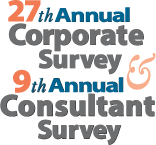
CONSULTANTS COMMENTARY
 Survey Results Point to a "Positive Hold"
Survey Results Point to a "Positive Hold"Brett Hunsaker, executive vice president and regional managing director at Newmark Grubb Knight Frank
 Emergence of Big Data Affects Corporate Survey Respondents' Priorities
Emergence of Big Data Affects Corporate Survey Respondents' PrioritiesBill Luttrell, senior locations strategist at Werner Enterprises
 Corporate Survey Results Mirror General Market Trends
Corporate Survey Results Mirror General Market TrendsChristopher B. Schastok, vice president at Jones Lang LaSalleg
 Corporate Survey Reflects the New Economic Normal
Corporate Survey Reflects the New Economic NormalThomas Stringer, Business Advisory Services, Ryan & Company
Of significant concern to our industry, as well as our clients, is the inability of the legislative and executive branches to agree on anything meaningful regarding the economy — and it is the opinion of this consultant that the blame and finger-pointing is shared by everyone. I hope, by the time publication of this article occurs, I will have fingers pointed at me as a negative worry-wart who is overconcerned with our legislators’ ability to work together; however, I suspect this will not be the case at all.
An encouraging realization from the survey comes from the comment that overseas manufacturers are having problems with product quality and rising labor and energy costs (each cited by a fifth of the Corporate Survey respondents), so much so that some are considering moving operations back to the United States. While this is encouraging from one perspective, it should be considered in the context of how important site selectors (and their clients) consider skilled labor. The availability of skilled labor factor was one of the highest ranked site selection factors (53.9 percent considered it “very important,” 35.5 percent considered it “important”), with highway accessibility (57 percent “very “important,” 33.1 percent “important”) listed as more significant. Economic development policymakers need to pay attention to the availability of skilled labor, since it will probably be the most important differentiating factor for site selection in the future.




